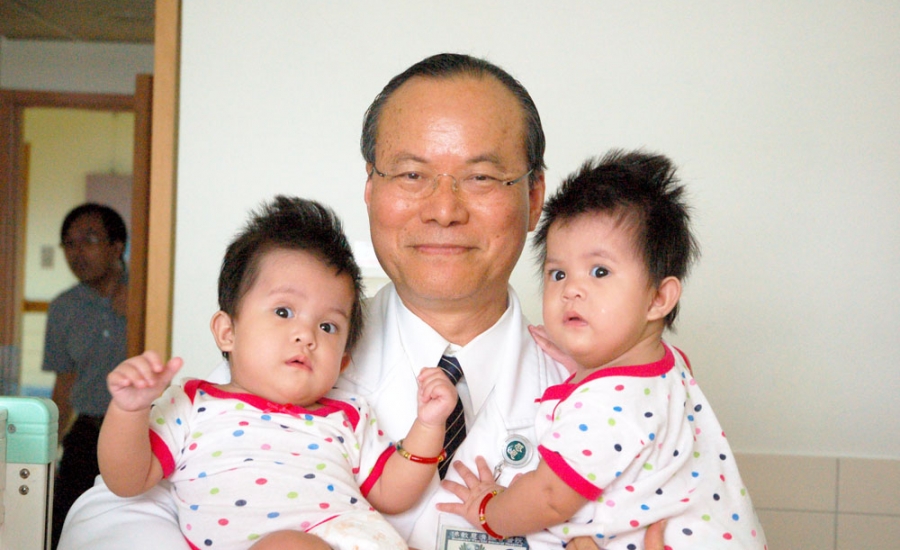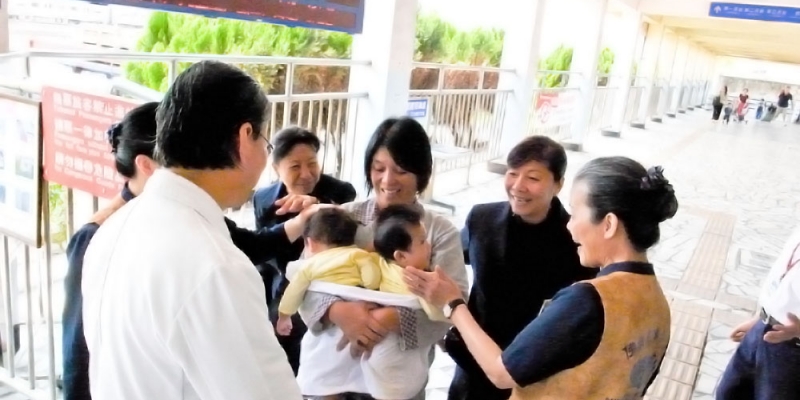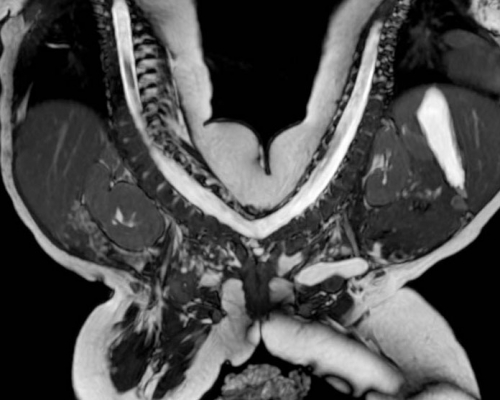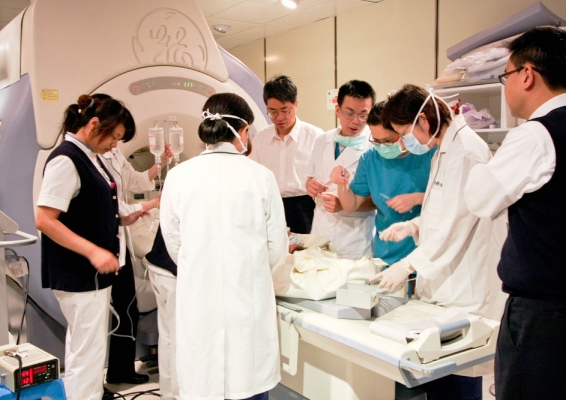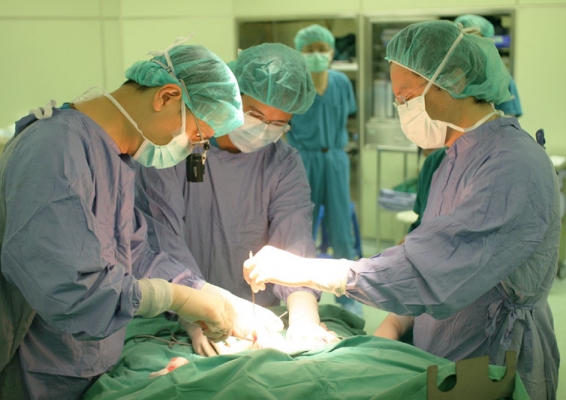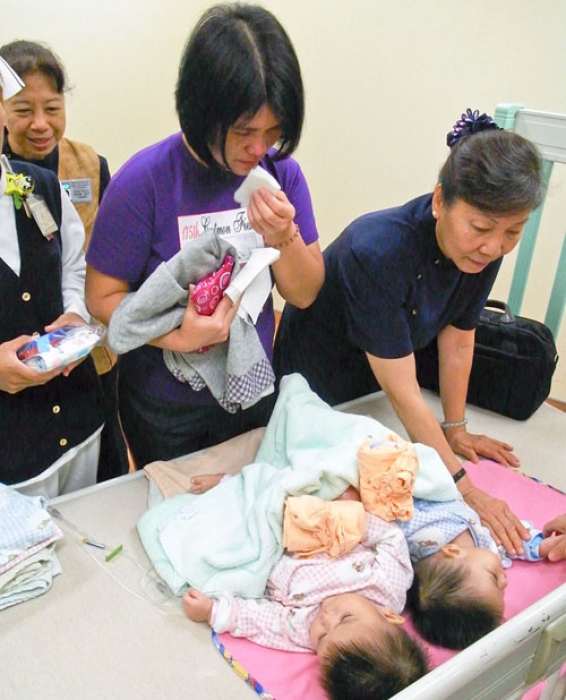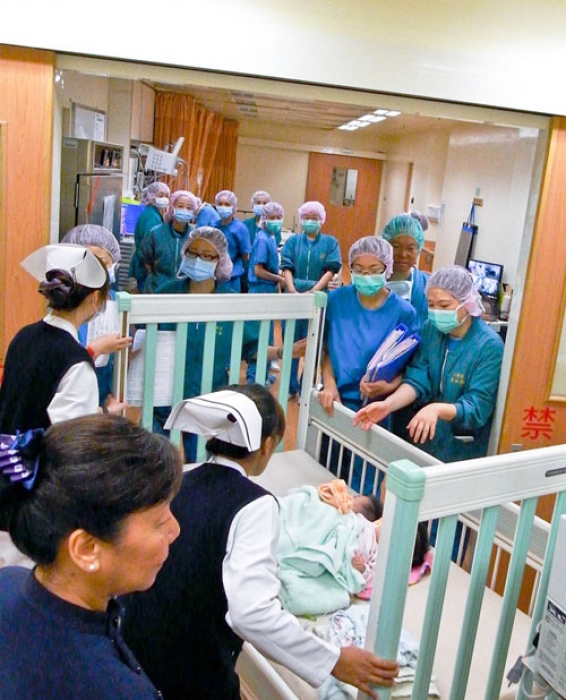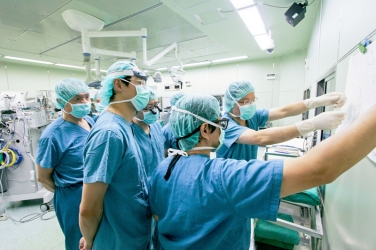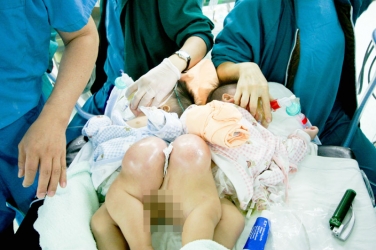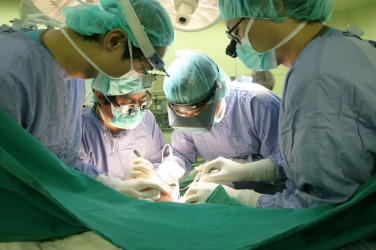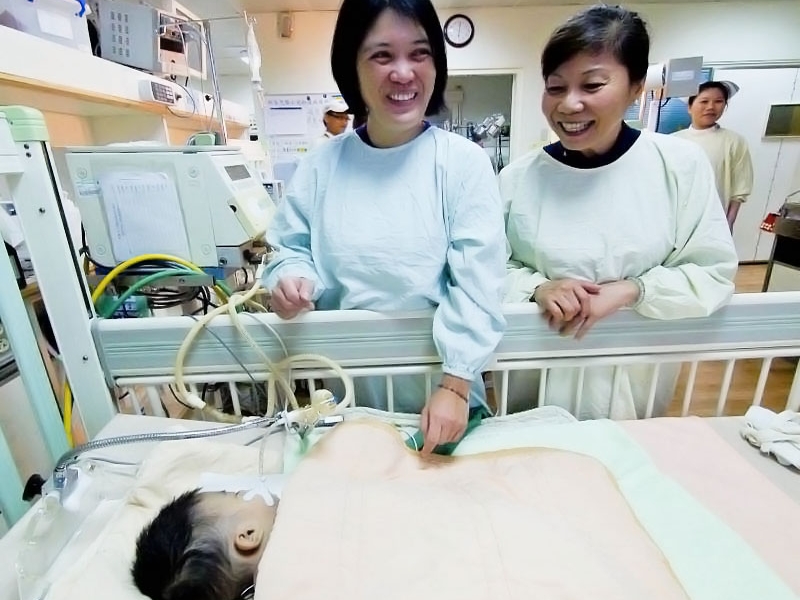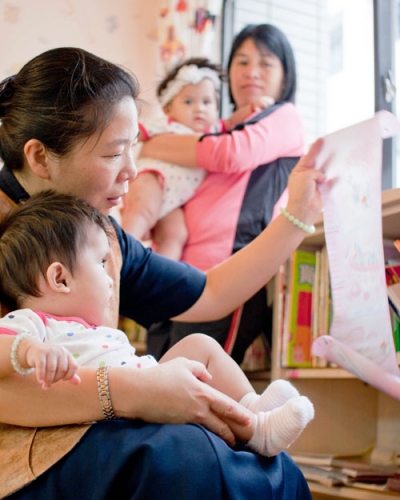First Successful Case of Separating Conjoined Twins at the Buttocks in Taiwan
Written by Si-Chi Huang
In 2003, TIMA Philippines discovered a pair of conjoined twins connected at the chest and abdomen. The twins were successfully separated under the care of a medical team from Tzu Chi General Hospital in Hualien City, Taiwan. The two little girls, named Tzu-Ai and Tzu-En returned to the Philippines and started a new chapter in their lives. At the end of 2009, Tzu Chi volunteers in the Philippines encountered another case of conjoined twins, who, in this case, were connected at the buttocks. The mother, Emile, and her daughters, accompanied by Tzu Chi volunteers, traveled to Hualien for treatment. Both of the two beautiful little girls have names starting with “rose” and are affectionately dubbed, ‘the Rose Sisters.’
The Rose Sisters, joined at the buttocks, are two individuals with different characters.
One sister cried a lot while the other smiled always; often one was awake while the other was sleeping. The mother was exhausted taking care of them.
Tzu Chi medical team went through a three-month marathon on examining and mock surgery. In June 2010, the conjoined twins were successfully separated after a surgical operation over seven hours with a team of more than 20 doctors and nurses.
This was the first successful case of separating conjoined twins connected at the buttocks in Taiwan medical history. The achievement was a collaborative effort of all medical personnel and volunteers. With great love, the suffering of the conjoined twins and their parents was relieved.
The Rose Sisters are now rolling around individually, learning how to sit and crawl, and heading toward an exciting future.
Accompanied by the Phillipine volunteers Jian-Lan Lee (second left) and Li-Jiun Chen (second right), Emile and her twins seeked medical helps in Taiwan. Dr Hai-Chi Peng (first left), who had visited Emile in the Phillipines, greeted her at the station that warmed Emile. Photo taken by Yung-Seng Lin
Under the joint efforts of Tzu Chi volunteers from the Philippines and Taiwan, in late March of 2010, Emile and her two precious conjoined twin daughters arrived at Hualien Tzu Chi General Hospital from the Philippines. On June 5, 2010, after two months of preparations, the conjoined twins connected at the buttocks were formally separated. The usually sturdy Emile was overwhelmed with emotion and could not hold back her tears.
“From the very beginning, when Tzu Chi volunteers showed up at my door, I have been worried that this might be a dream. When I saw my two dear daughters sleeping in two separated beds peacefully; I realized that my dream has come true!”
A Rare Case of Conjoined Twins Connected at the Buttocks
Every new life is a joyful blessing from Heaven. The joy was doubled when Emile Molit, a high school teacher, and her husband Salomeo Molit Jr. knew that they were having twins. However, the antenatal checkup reported a harsh news that the twins were connected at the buttocks sharing one anus. The twins were born on September 21, 2009, and the medical fees soared to 100 thousand Peso within two days. It was quite a burden for the couple who already have two children.
A new life begins when a sperm fertilizes an egg that becomes an embryo. If the embryo splits and develops into two fetuses, it is the identical twins. The split normally occurs during the first 12 days after conception. However, if the embryo splits after 13 days, there is a chance that the split will result in conjoined twins because of incomplete separation of the two fetuses.
The chance of a conjoined twin is about one in 50,000 to 100,000. Literature suggests that most conjoined twins are females. The exact cause of conjoined twins is not known. In Taiwan, conjoined twins are very rare due to the quality of prenatal care service and advanced medical imaging technology. In global medical history, most reported cases involveing Siamese twins are connected at either the chest or the abdomen. Conjoined twins connected at the hip, like the Rose Sisters, are rare.
Financial Difficulty
her husband, Salomeo Molit, Jr., works in a factory. They live in a small town called Catmon, in Cebu province of the central Philippines. Because of the economic recession, Salomeo has no stable employment. The family of 12 people is mainly supported by Emile’s income. Her monthly salary of 15,000 Philippine Peso has to pay for the mortgage and living expenses for the entire family, including school tuition for her two older children.
The Rose sisters were conjoined twins connected at the buttocks. Fortunately, apart from the 2.5cm shared central nervous systems, the sisters have independent organ systems.
Last year, Emile found out that she was pregnant. A prenatal examination indicated that Emile was pregnant with twins. She struggled with her pregnancy at the relatively advanced age of 36; however, with the encouragement and support of the family, she decided to cherish this gift of lives. Since there is no large hospital in the small town Catmon, Emile had to drive two hours to the Cebu city for prenatal care every two weeks. Unexpectedly, when she was 5 months into pregnancy, her physician told her that she probably carried conjoined twins.
On October 21, 2009, under a mixed feeling of anxiety and uncertainty, Rose Carmel Molit and Rose Carmelette Molit were born. As predicted by the doctor, the babies were conjoined twins connected at the buttocks.
Soon after, Emile and her husband struggled to pay for the newborns’ living and medical expenses. The cost of the Caesarean section alone cost more than 100,000 Philippine Peso, which is beyond their ability to pay. They had no choice but to seek help from the local society. The major of Catmon visited Emile and suggested her to seek help from the Tzu Chi Foundation, which had held a free clinic in town on June 29, 2008. Two weeks after giving birth to the twins, Emile, still in recovery, showed up in the office of the Tzu Chi Foundation in Catmon.
High Chance of Success
Emile said, “I used to believe that if you do not have money, you do not have access to medical care, and my daughters, Carmel and Carmelette, would have no future. But Tzu Chi volunteers told me not to worry about money, but to think about how to take care of my twin daughters first.”
Emile recalled that when she arrived in the Tzu Chi office in Catmon, the volunteer on duty was Ms. Jian-Lan Lee. Ms. Lee listened and comforted Emile. She contacted a member of TIMA, Mr. WeiGuo Lee. In addition to giving professional advice, Tzu Chi volunteers also shared with Emile the story of the successful separation of the conjoined twin sisters, Tzu-Ai and Tzu-En. This shed a light of hope for Emile.
The sisters underwent an MRI with the help of anesthesiologists and nurses. The sister took the first surgery on April 8, 2010; surgeons implanted a tissue expander to culture more skin.
In December 2009, Philippine Tzu Chi volunteers arrived in Taiwan for a meeting. They discussed the case of the Rose Sisters with the same Tzu Chi medical team that carried out the successful separation for the conjoined twins, TzuAi and Tzu-En, in 2003. To investigate the possibility of a surgical separation of the Rose Sisters, they arranged for X-ray and CT (Computed Tomography) scans at the local hospital in the Philippines and the results were sent to Taiwan for diagnostic and review. After examining all the reports, the chairman of Pediatric Surgery in Tzu Chi Hualien General Hospital, Dr. Hai-Chi Peng, arrived in the Philippines to conduct a preliminary assessment.
“In evaluating the safety of separating conjoined twins, it is not only important to examine the connected regions; the expert has to consider if there is any abnormality in the non-connected regions such as the sharing or fusion of organs, or major abnormalities in the vital organs of the heart, lung, and brain. These are important factors determining the feasibility of a surgical operation,” Dr. Peng recalled the instructions from his advisor while he was in training at the Philadelphia Children Hospital in 1988.
Through ultra sound and CT scan studies Dr. Peng determined that the Rose Sisters were connected in the hip and shared a common anus; there were no other connections in vital organs. Physical palpation indicated that even though the sisters shared a common anus, there were two rectums joined side by side. From his team report and his own personal assessment, Dr. Peng concluded that the success rate for the operation can be almost a 100 percent.
The First Stage of Surgical Operation
On March 31, under the assistance of Tzu Chi volunteers from the Philippines and Taiwan, Emile, together with her 5-month old conjoined twin daughters arrived in Taipei, Taiwan from Manila.
They boarded a train to Hualien immediately. At 4 pm in the afternoon, Dr. Peir-Rong Chen, Vice President of the Tzu Chi General Hospital, assembled a team of experts from pediatric internal medicine, pediatric surgery, neurosurgery, plastic surgery, anesthesiology, and medical imaging. They conducted a joint diagnostic session to discuss the possible treatment strategy, the arrangement for further examinations, and the details of surgical operation. They also took physical measurements of the sisters for a follow up treatment plan. They decided to call for a team conference every two weeks in order to update the medical condition of the Rose Sisters and to make appropriate adjustment accordingly.
photo1: Before the separation surgery on June 5, 2010, Emile, the mother, accompanied the sisters.
photo2: The pediatric team handed over the sisters to the surgeons.
Through MRI (Magnetic Resonance Imaging) and CT scans, the medical team was able to understand the condition in which the muscle, bone, and nervous system are connected, and to calculate precisely the size of the wound after surgical separation of the conjoined twins. On April 8, the medical team conducted a preparative stage of the surgical operation - putting in the tissue expander and performing a colostomy. To reduce the number of anesthetic procedures, they also conducted a sigmoidoscopy, a bladder endoscopy, and an ultrasound imaging during this operation.
Dr. Peir-Rong Chen, who assembled the treatment team, explained: “The use of tissue expander is to stretch the skin in order to make sure there is enough skin tissue to cover the open wound created by the separation surgery; colostomy is to provide a temporary, separated, artificial anus for elimination. These are preparatory works to facilitate plastic reconstruction and toreduce the possibility of gastrointestinal contamination before and after surgery. Careful examination during the first stage of the operation demonstrates that the two sisters have some connection at the nerve endings, even though there is no connection in vital organs. Thus, the main issue for the team will be how to reduce adverse post-surgery effects due to possible neurological damage.”
Nurses Comfort Stressed Mother
While the medical team was planning all the details of the operation, the nurses took care of the daily life of the mother and daughters. They also comforted Emile to ease her stress of being away from home. On May 9, Emile and her two daughters celebrated the Mother’s Day in the hospital. Nurses off duty that day brought in carnation and a cake for Emile. The head nurse of the pediatric unit, Ya-Jun Zheng, said, “Emile was really surprised and happy when the cake was brought in the room.”
Emile said, “I feel the medical team and nurses are very kind and caring; they treat me and my daughters like family members. I am not worried and have full confidence in the doctors and nurses.”
During the time when the medical team carried out multiple simulated operations in preparation for the actual separation surgery, Emile was stressed and even agitated. Every time the health professionals examined the conjoined twins, Emile would keep her distance without much expression on her face. Under gentle comforting and caring by the nurses and volunteers, she slowly let down her guard and open up.
Zheng continued, “From the birth of the conjoined twins, to traveling across the ocean alone with her two daughters seeking treatment, Emile has been through a lot. One can imagine the economic and emotional pressures in Emile’s mind; one can also understand her helplessness in facing an uncertain future.”
Zheng asked her colleagues to read about how to care for conjoined twins and practice conversation in English; she also arranged for the same team of nurses to take care of the mother and daughters and provided English name tags for health professionals on duty. The service department sent in a modified push cart, diapers, and milk powder. Volunteers and nurses provided a sterilizer for milk bottles, an electric water heater, and various cloth dolls and toys.They wanted Emile and her daughters to feel at home as much as possible.
There is no available disposable diaper for these conjoined twins and the Rose Sisters developed diaper rash. Under the guidance of volunteers, Emile started to use traditional cloth diapers. Emile hand-washed all the diapers and clothes and hung them up in the room. Nurses and volunteers were eager to assist. In the beginning, the Rose Sisters would cry whenever they saw the nurses in white uniforms. After they befriended the nurses, they wanted the nurses to hold and comfort them.
Even though Emily prepared herself psychologically, she was unsettled. The day before the separation surgery, Emile and her daughters, accompanied by the medical team, came to Jing-Si Abode to visit Dharma Master Cheng Yen for her blessing.
Emile said, “Even though I don’t understand a word of Chinese, but I knew that Master Cheng Yen has given her blessings to me and my daughters. I could not hold back the tears…”
The very moment she saw Master Cheng Yen, Emile broke down and cried for the first time in front of the medical team. It was as if she were home with her family members where there was no need to hide. Since the day she was pregnant, Emile had been struggling financially and mentally. This long suppressed feeling was finally relieved on the eve before the separation operation.
Successful Operation for the Twins
On May 29, one week before the actual separation surgery, the treatment team conducted simulated separation operations. Dr. Peng explained, “In the separation surgery, there will be two teams simultaneously carrying out the surgical operations; thus, coordination, space arrangement, timing, and team communication are very important. In multiple, repeated, simulated operations, we have to work out all the planning and details, including the positions of incision, the positions and movement of all team members, and the possible adverse events.”
Dr. Peng commented further, “The conjoined twin sisters have a connected region of about 36 cm long at the buttocks. The other organs are developed normally. They have very different temperaments; one sister can be sleeping while the other sister is crying. To facilitate their future psychological and physical development, it will be necessary to separate them. However, in the process of separating conjoined twins into two individuals, there will be inevitable damages to the connecting tissues. It is challenging in terms of anesthesiology, surgery, and post surgery reconstruction. The most important issue is to reduce the postoperational adverse effects to minimum.”
At 9:18 am on June 5, Dr. Peng made the first incision and formally commenced the separation surgery. Two surgical teams, led by Dr. Hai-Chi Peng and Dr. Ming-Che Lee, carried out the surgical operations simultaneously on the same table. First, they cut open the connected skin, removed the tissue expansion devise, and then worked into the deeper levels. Then the neurosurgery team, led by Dr. Tomor Harnod, separated the nervous systems. This was followed by surgical separation of the connected rectum, anus, and perineum. At 1:30 pm, the conjoined twins were physically separated. Finally, the separated sisters were placed on two operation tables and the plastic surgical team, led by Dr. Jiunn-Tat Lee, started the plastic surgery to repair the wound and close-up procedures.
photo2: Sufficient new skin for the opening after surgery were successfully cultured with the implanted tissue expander.
photo3: Dr. Hai-Chi Peng (right second) laid the first cut and the separation surgery began.
The first challenge in the operation was the anesthesia, because infants react to anesthesia rapidly. Besides being careful about the dosage of anesthesia, we had to watch the interactive response of the conjoined twins,” commented by Dr. Tsung-Yin Chen, Director of Anesthesia Department.
Dr. Ming-Che Lee added, “Sterilization was the next challenge. The combined weight of the conjoined twins is about 13 Kg. They were attached with wires and tubes for anesthesia, and monitoring devices for vital signs. For whole body sterilization, we had to raise the twins simultaneously and maintain them in a vertical position until the sterilization procedure was completed. In addition to constant silent communication, we had to work in a concerted, stable, and gentle fashion.”
Dr. Tomor Harnod described the most worrisome problem of separating the nervous systems. “The ends of the conjoined twins’ central nervous systems were connected for about 2.5 cm in length; their coccygeal nerves were entangled into a Y shape. All we could do was to be as carefully and precisely as possible and to separate the nerves in a balanced fashion. We anticipate that there will be inevitably post-operational effect on the function of elimination.”
Dr. Peng commented, “Young children have amazing potential for growth and healing; hopefully, their reproductive, urinary, and anal function will rapidly achieve normality. The best time to separate conjoined twins is 3 to 12 months of age. Separation surgery should be followed by rehabilitation. Different problems may appear later in different stages of development and appropriate treatment should be applied. In general, most physiological functions will reach to certain extent of normality.”
The overall surgical operation lasted for more than seven hours. In summary, during those seven hours, the surgeons divided and repaired muscle and nerve tissues, reconstructed the colon, rectal, perineum, and anus, and finally repaired and closing up the wound. At 4:25 pm, Carmel and Carmelette were wheeled out of the operation room. Vice president Dr. Chen announced, “The separation surgery was successfully carried out according to plan. There was no need of blood transfusion during the operation. The following two days will be the critical recovery period for the Rose Sisters and they will be closely observed.”
After the separation operation, Emile rushed into the children intensive care unit to see her two precious daughters. Emile was moved to tears. She said, “Besides being grateful, I don’t know what else to say!” She could not take her eyes away from her two independent little daughters. She could not believe that after seven months of waiting, her dream had come true.
The Twins Smile at Their Independent Lives
Three days after the surgery, the Rose Sisters were transferred to the general patient’s room. To care for the twins, Emile and the Tzu Chi volunteers from the Philippines hardly had time to rest. However, when Emile saw the two precious daughters lying next to her, she had a smile on her lips.
There is a common saying in Taiwan: “Children sit at the seventh month, crawl at the eighth month, and teething at the ninth month.” Times went by fast; by July, the Rose Sisters were eight months old.
The chairman of the Pediatric Department, Dr. Chia-Hsiang Chu said, “Before the separation surgery, the connected Rose Sisters were making attempts to move their limbs as if they wanted to crawl. Now they can move freely without the hindrance of the other sister. Their physical development is normal and stable. We have already started rehab treatment.”
The surgery was successful after seven hours of operation. Emile, the twins' mother, had smiles on her face finally.
The Rose Sisters are learning how to wave their hands, turn over, sit up, and crawl. The rehab team wants to quickly teach the sisters while they are still young and malleable to correctly use their spine in bending sideway. They also taught Emile the techniques to correct the spinal movement of each sister after returning to the Philippines. The Rose Sisters are still not used to the idea of being separated; they tend to push each other away when they are close to each other. This confirms the decision of the medical team and their colleagues that after all, the conjoined sisters are better off separated.
Lying on two sides of a big bed and blinking their big bright eyes, the Rose Sisters are chewing teething biscuits. Under the loving care of the medical professionals, the Rose Sisters are recovering rapidly and stably. Carmel can say the words like “Ma Ma” while Carmelette is first to say Taiwanese words “Ah Mu” meaning mother. They have been away from home for four months. Emile took out family pictures and showed the sisters how to say the names of each family member. She hopes that when they go home to unite with the family in the Philippines, the sisters will surprise them.
The Rose twins are finally independent. Photo shows Carmelette is accompanied by hospital volunteer Ms. Chang while Carmel in their mom' arms.
The treatment team noted that the Rose Sisters each has good appetite and each is active. Their wounds are healing rapidly. On July 31, the medical team did the last surgery to close the temporary anus and reconnect the colons. This marked the end of the entire separation operation. The Rose Sisters were released from the hospital and embarked on a new life journey back home.
After the first successful separation of the conjoined twin sisters, Tzu-Ai (Lea) and Tzu-En (Rachel) in June of 2003, this was the second successful separation of conjoined twins by the medical team from Tzu Chi Hualien General Hospital. The case of the Rose Sisters marks the first successful separation of conjoined twins connected at the buttocks in Taiwanese medical history. The treatment process had many challenges and involved experts from pediatrics, pediatric surgery, plastic surgery, neurosurgery, anesthesia, radiology, nursing, and rehab in Hualien Tzu Chi General Hospital. In addition to medical professionals, there were participants from Tzu Chi volunteers and administrative colleagues from the hospital. This ground breaking achievement is the result of a concerted team effort, carried out with great love, care, and dedication.

